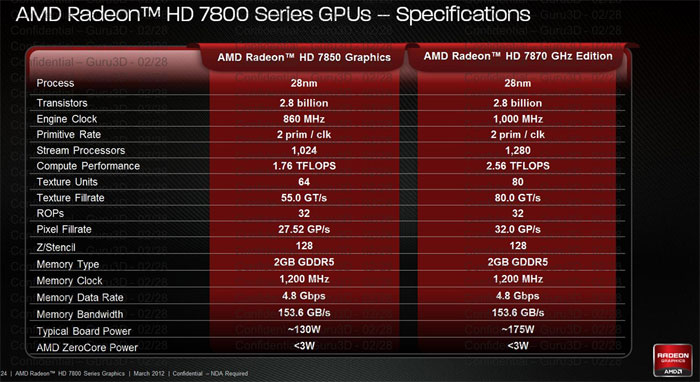Specs and Southern Islands
Southern Islands
You've been hearing several codenames flying around and that can be a little confusing, so as we always do, let's explain that first. It's simple really, in the market we have entry level, mainstream and high-end products. When you notice "Cape Verde" that's the entry level Radeon HD 7700. Next in line is "Pitcairn" which is the codename for AMD's mainstream products and thus the series 7800 tested today. Finally there's "Tahiti" which is the codename for the GPU used in the most high-end products.
- Entry level = Cape Verde = Radeon HD 7700 series
- Mainstream level = Pitcairn = Radeon HD 7800 series
- High-end level = Tahiti = Radeon HD 7900 series
The entire segment from top to bottom is now released in Q1 2012, the 28nm stack has been filled. We do expect to see some respins and slightly different SKUs over time, but basically this is the entire lineup. That said, of course a dual-GPU based Tahiti graphics card is still pending launch. We shall name that the Radeon HD 7990 for now.
Technology
It is important to understand that there are significant changes in this family of GPUs. The GPU architecture was overhauled, AMD moved towards a 28nm process technology, the new cards are all PCIe gen 3 compatible and there have been significant changes on power consumption. We'll address all these features separately of course.
With the launch of the Radeon HD 7000 series Eyefinity has been updated to version 2.0. DDM audio is now fully supported (you hear audio on the actual monitor it's played on), a new 5x1 landscape mode is introduced, and you may now create custom multi-monitor resolutions.
Radeon HD series 7800
We start off with the GPU overview. AMD now bakes GPUs on the all new 28nm node, in very simple wording that means they can put more transistors on a smaller processor die area, typically resulting in less power consumption as well.
The Radeon HD 7800 Pitcairn graphics core has a good 2.8 Billion transistors, the internal architecture has changed compared to the previous generation products, we'll talk a little deeper about that in a minute, but as a result:
- The Radeon HD 7850 is packed with 1024 shader processors harbored in Compute Unit segments (16 of them). The board power is rated at 130W, the actual TDP will be a little lower as we'll demonstrate later on.
- The Radeon HD 7870 is packed with 1280 shader processors harbored in Compute Unit segments (20 of them). The board power is rated at 175W, the actual TDP will be a little lower as we'll demonstrate later on.

Memory wise both cards in reference form will pack 2 gigabytes of gDDR5 memory, quite a bit for mainstream level products. The memory bus is 256-bit, but combined with the gDDR5 memory (which is quad data rate) you do get a decent chunk of much needed memory bandwidth, which the GPU can certainly use. The memory clock will be 1200 MHz on both products, being quad data-rate (gDDR5) that results in an effective data rate of 4800 MHz or 4.8 GHz. This will give the Pitcairn GPUs 154 GB/sec of framebuffer bandwidth in which to do their thing.
The Pitcairn GPU packs 2.8 billion transistors, but if you can't apply a fast enough clock frequency it would become a problem. Well, that's not an issue for AMD either, the R7850 is clocked at 860 MHz while the Radeon HD 7870 will get a reference core clock frequency at a full GHz. Obviously board partners are free to define faster factory clocks.

